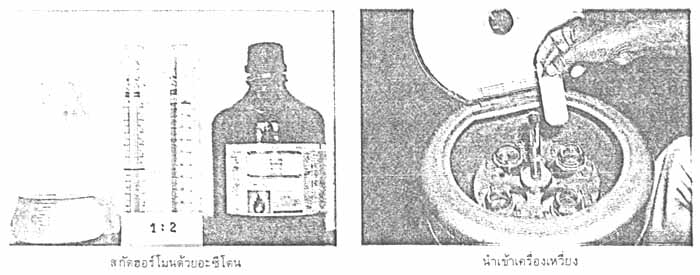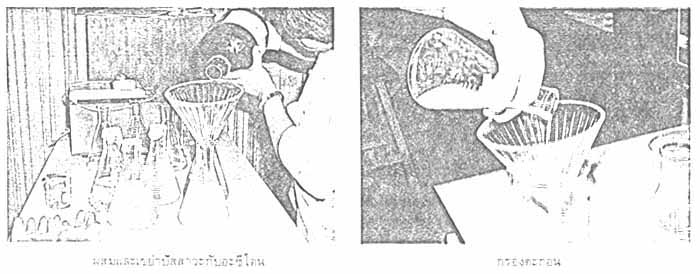
| NACA/WP/88/74 | DECEMBER 1988 |
 | INDUCED SPAWNING BY USING HCG PRODUCED FROM URINE OF PREGNANT WOMEN |
Manob Tangtrongpiros, Khamchai Lawonyawut
Sujin Nukwan
National Inland Fisheries Institute
Bangkhen, Bangkok
Thailand
1988
Hyperlinks to non-FAO Internet sites do not imply any official endorsement of or responsibility for the opinions, ideas, data or products presented at these locations, or guarantee the validity of the information provided. The sole purpose of links to non-FAO sites is to indicate further information available on related topics.
This electronic document has been scanned using optical character recognition (OCR) software. FAO declines all responsibility for any discrepancies that may exist between the present document and its original printed version.
Manob Tangtrongpiros, Khamchai Lawonyawut
Sujin Nukwan
ABSTRACT
The experiments were carried out by the biologists in the Aquaculture Research Group, of the National Inland Fisheries Institute. Urine was collected from pregnant women during 2–3 months of gestation at Rajavidhi Hospital. The crude hormone was extracted by acetone precipitation method. Hormone powder was obtained by using freeze drier technique. The amount of HCG was measured by Double Antibody Quantitative HCG Radioimmunoassay. Hormone was kept in the vials with 5,000 IU per vial. Total amount of 156 vials or 780,000 IU were produced during December 1986 – July 1987. The cost of hormone production per vial was 7.12 baht. Produced hormone can be used effectively for induced spawning of all types of catfish such as Clarias macrocephalus, Clarias batrachus and Pangasius sutchi.
INTRODUCTION
Artificial breeding method by injection with fish pituitary gland extract, sometimes combined with chorionic gonadotropin, is widely used in Thailand. The insufficient supply and low quality of pituitary gland are the main constraints. Imported chorionic gonadotropin is not cost effective. Therefore HCG from pregnant women might be used instead.
OBJECTIVES
Find out the appropriate method to produce crude HCG.
Compare the efficiency and cost effectiveness of HCG from this source with other types of hormone.
Observe the live span of HCG.
METHODS
Urine from 2–3 months pregnant women obtained from Rajavidhi Hospital during December 1986 to July 1987. HCG was extracted by precipitation with acetone at the ratio of 1 part urine and 2 parts acetone, shaken for 10 min kept at 4°C, and the clear solution poured out. The precipitable part was collected by centrifuge at 4,000 rpm for 10 min and then filtered through Whitman No. 41. The precipitate was kept at 4°C until used. The crude HCG freeze dried for 20 hrs. HCG was kept in vial with 0.01 gm/vial. The concentration of HCG was measured by Double Antibody Quantitative HCG Radioimunoassay.
RESULTS
Crude HCG production - The 156 vials of HCG were produced during December 1986 and July 1987. The concentration is 5,000 IU/vial. One liter of urine can produce 50,000 IU of HCG.
Effect of HCG - Induced spawning with HCG was tested with 4 species, namely Clarias, Pangasius, Rohu and Puntius. The results are shown in Table 1.
Production cost - Production cost at one time to get 56 vials with 5,000 IU/vial. Total HCG concentration was 280,000 IU. Cost of 11.2 liters of acetone, 298.67 Baht, laboratory cost 100 Baht. Cost per IU was 0.0014 Baht. Production per vial (5,000 IU) was 7.12 Baht.
Effectiveness - Urine from first 2–3 months of pregnancy are recommended for HCG extraction; collection therefore should be timely. The doses of 2,000 – 8,000 IU/kg of spawner are appropriate for Clarias, Pangasius and Mystus. HCG had no effect on Puntius and Rohu. Induced spawning of C. macrocephalus cost 14–15 Baht with the use of HCG and 75 Baht for PG.
Table 1. Effect of crude HCG on induced spawning.
| Date | Species | ♀ | Total wt (gm) | Dose IU/kg | Spawning % | Hatching % | No. of Survival |
| 20 May 87 | C. | 5 | 1.000 | 8,000 | 100 | 90 | 5,000 |
| 22 May 87 | 5 | 1,000 | 8,000 | 100 | 80 | 2,875 | |
| 25 May 87 | 6 | 1,700 | 6,000 | 100 | 80 | - | |
| 25 May 87 | 6 | 2,000 | 6,000 | 100 | 80 | - | |
| 26 May 87 | 3,000 | 5,000 | - | - | - | ||
| 26 May 87 | 3 | 9,000 | PG 1 Dose | 100 | 90 | - | |
| PG 3 Dose | +300 IU/kg | - | - | ||||
| 26 May 87 | 4 | 1,000 | 6,000 | - | - | - | |
| 28 May 87 | 4 | 1,000 | 6,000 | - | - | - | |
| 1 June 87 | 6 | 1,000 | 6,000 | 100 | 80 | 2,000 | |
| 1 June 87 | 3 | 1,000 | 6,000 | 100 | 80 | 3,500 | |
| 8 June 87 | 2 | 1,000 | 7,000 | 100 | 40 | 3,500 | |
| 15 June 87 | 3 | 1,000 | 7,000 | 100 | 70 | 3,000 | |
| 29 June 87 | 4 | 1,000 | 8,000 | 100 | 80 | 3,000 | |
| 6 July 87 | 4 | 1,000 | 8,000 | 100 | 70 | 3,000 | |
| 20 July 87 | 3 | 1,000 | 8,000 | 100 | 90 | 3,500 | |
| 27 July 87 | 6 | 1,000 | 5,000 | 100 | 85 | 3,200 | |
| 4 Aug.87 | 6 | 1,000 | 5,000 | 83.33 | 80 | 4,460 | |
| 6 Aug.87 | 19 | 1,000 | 5,000 | 100 | 50 | - | |
| 10 Aug.87 | 21 | 3,000 | 5,000 | 90.48 | 60 | 3,000 | |
| 23 Sept.87 | 9 | 567 | 1,000 | - | - | - | |
| 23 Sept.87 | 9 | 567 | 2,000 | 11 | - | - | |
| 23 Sept.87 | 8 | 504 | 3,000 | 62.5 | - | - | |
| 23 Sept.87 | 9 | 567 | 4,000 | 66.67 | - | - | |
| 23 Sept.87 | 23 | 1,449 | PG 0.5 | 82.6 | - | - | |
| Dose; PG | 1 Dose 30 Iu |
ACKNOWLEDGEMENT
The authors thank Dr. Kitjar Jaiyen, Director of the Inland Fisheries Institute for this support of this research and Miss Sukanya Virawattranagoompa of Chulalongkorn University for her helpful suggestions.
Special thanks are given to Miss Duangjai Tantiyaporn and the Director of Rajvithi Hospital for providing laboratory analysis.
 | |
| extract by aceton | centrifuge |
 | |
| mixed urine with aceton | filtered |
 | |
| sedimentation | liopjilization |
 | |
Figure 1 HCG extract process
REFERENCES
Bahl, OM.P. 1977. Fed. Proc. 36: 2119.
Diagnostic Products Corporation. 1985. Double Antibody HCG. Diagnostic Products Corporation, Los Angeles, 15 p.
Diczfallusy, E. and Troen, P. 1961. Vitams Horm. 10 : 229.
Hirunyavasit, V. 1978. Production and Mechanical study of Human Chorionic Gonadotropin. Master Thesis. Department of Chemical, Faculty of Science, Mahidol University, 127 p.
Kongsak, D. 1984. Hormone Treatment and Diagnosis of Clinical Gynecgolic Endocrionology, Faculty of Medicine, Ramathibhadhi Hospital, Bangkok, 153 p.
Kusumran, T. 1979. Production and Mechanical Study of Human Chorionic Gonadotropin (HCG) for Medical and Agricultural purposes. Department of Chemical Faculty of Science, Mahidol University. 29p.
Ngamvonchon, S. 1984. Induced Spawning of Clarias macrocephalus by Using Hormone from the Urine of Pregnant Women. National Inland Fisheries Institute. 30 p.
Ngamvonchon, S. and Tungtrongpiros, M. 1983. Induced Spawning of Clarias macrocephalus by using Hormone from the Urine of Pregnant Women. National Inland Fisheries Institute. 37 p.
Ngamvonchon, S. 1981. A preliminary study of hormone from the urine of pregnant women to induce some freshwater. Thesis is for Master of Science, Faculty of Graduate Studies, Mahidol University.
Power, K.R. 1986. Artificial Spawning of Fishes Using Hormone. Part 2: Practical Techniques for Aquarists. Tropical Fish Habbyist. March, 78– 83.
Rowland, S.J. 1983. The Hormone-induced Ovulation and Spawning of the Australian Freshwater Fish Golden Perch, Macquaria ambigua (Richardson) (Percichthyidae). Aquaculture, 35:221–238.
Rowland, S.J. 1984. The Hormone-induced Spawning of Silver perch, Bidyanus bidyanus (Mitchell) (Teraponidae). Aquaculture, 42 (1984) 83–86.
Virawattranagoompa, S. 1982. The First Training on Clinical Application of Radio Immunoassay. Department of Faculty of Medicine, Chulalongkorn University. 213 p.
